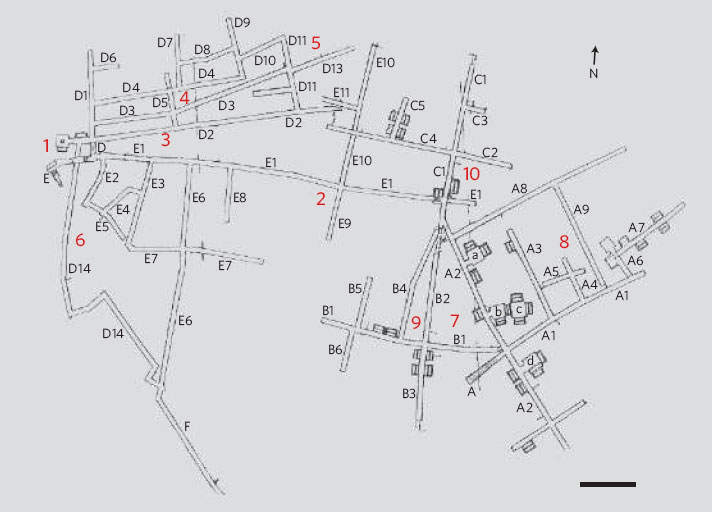
 |
Freethought & Rationalism ArchiveThe archives are read only. |
|
|
#1 | |
|
Senior Member
Join Date: Nov 2004
Location: Why am I still up? It's way past my bedtime.
Posts: 508
|
Did anyone catch this story? Study was supposedly published in the July 21 issue of Nauture.
Any analysis or comments? http://www.livescience.com/history/0..._catacomb.html Quote:
|
|
|
|
|
|
#2 | |
|
Contributor
Join Date: Jun 2000
Location: Los Angeles area
Posts: 40,549
|
National Geographic article
Quote:
|
|
|
|
|
|
#3 |
|
Veteran Member
Join Date: Apr 2005
Location: Vancouver
Posts: 1,043
|
I'm not clear what is supposed to be surprising here...that Jews had a significant presence in Rome long before the Christian era seems a given since Jews had already been twice-exiled from Rome before the Second Temple even came down.
|
|
|
|
|
#4 | |
|
Contributor
Join Date: Jun 2000
Location: Los Angeles area
Posts: 40,549
|
The "suprise" is that the archeology does not agree with the standard history of early Christianity contained in the book of Acts. According to Acts and the conventional history, the split between Christianity and Judaism happened in the first century, and the railings in the gospels and Paul's letters against the "Jews" reflect that split. Historians assume that the edit of Jamnia refers to the expulsion of Christians from Jewish synagoges.
example of the conventional wisdom: Quote:
|
|
|
|
|
|
#5 |
|
Contributor
Join Date: Jun 2000
Location: Los Angeles area
Posts: 40,549
|
Here is a link to the full story in Nature: Death in Rome
The full article requires a subscription or an institutional affiliation. |
|
|
|
|
#6 |
|
Veteran Member
Join Date: Oct 2004
Location: Bordeaux France
Posts: 2,796
|
The so-called "soft volcanic rock" tufa is not volcanic at all. It is limestone, and indeed, hardens when exposed to air. Tufa is very common in France. This mistake could have been avoided in a paper which has scientific pretences.
|
|
|
|
|
#7 | |
|
Veteran Member
Join Date: Sep 2004
Location: Birmingham UK
Posts: 4,876
|
Quote:
If, as this research suggests Jews began building catacombs in the early 2nd century and Christians started copying them towards the very end of the 2nd century, then this copying occurred despite a split having occurred. I don't see any real difference for Jewish-Christian relations in this period between this suggestion and the traditional idea that Christians began building catacombs towards the very end of the 2nd century and Jews started imitating them in the early 3rd. (The important similarities between Jewish and Chrstian catacombs are IIUC generally accepted.) In general a split between two religious groups does not necessarily prevent borrowing of practices from one by the other. Andrew Criddle |
|
|
|
|
|
#8 | |
|
Contributor
Join Date: Sep 2000
Location: Alibi: ego ipse hinc extermino
Posts: 12,591
|
This post has been merged into an earlier thread on the topic
Hello BC&H folks! For a while now, I've been running a repository in E/C for abstracts of recent papers from Science, Nature etc. I've just found one that has little E/C relevance, but may be of interest to you nice people here. Rutgers et al, Nature 436, 339 (21 July 2005) Radiocarbon dating: Jewish inspiration of Christian catacombs Quote:
Let me know if you'd like a pdf of the full thing. Cheers, Oolon |
|
|
|
|
|
#9 | ||||
|
Contributor
Join Date: Sep 2000
Location: Alibi: ego ipse hinc extermino
Posts: 12,591
|
Quote:
 Erm, whoopee-doo? Who mentioned tufa? I imagine dead trees are common in France too, but -- just perhaps -- these folks do know what they're doing...? Quote:
Quote:
 Legend: For radiocarbon dates of samples taken from different construction sites, see supplementary information. Numbers refer to the sample origin; letter−number combinations refer to gallery number. Scale bar, 10 m. Quote:
|
||||
|
|
|
|
#10 |
|
Veteran Member
Join Date: Oct 2004
Location: Bordeaux France
Posts: 2,796
|
From :
http://www.livescience.com/history/0..._catacomb.html <quote> The Roman Jewish community, which dates back to the first century BCE, would have likely chosen to bury rather than cremate their dead. The same would have been true for the early Christians. Perhaps because of a scarcity of land, these groups began excavating the soft volcanic rock, called tufa, outside the city walls. "Tufa is fairly easy to work with, and it hardens once it's been exposed to the air," Rutgers told LiveScience in a telephone interview. <endquote> LiveScience speaks of a soft volcanic rock, called tufa. I agree with Rutgers. And, yes, this has not much to do with jewish or christian catacombs. |
|
|
| Thread Tools | Search this Thread |
|